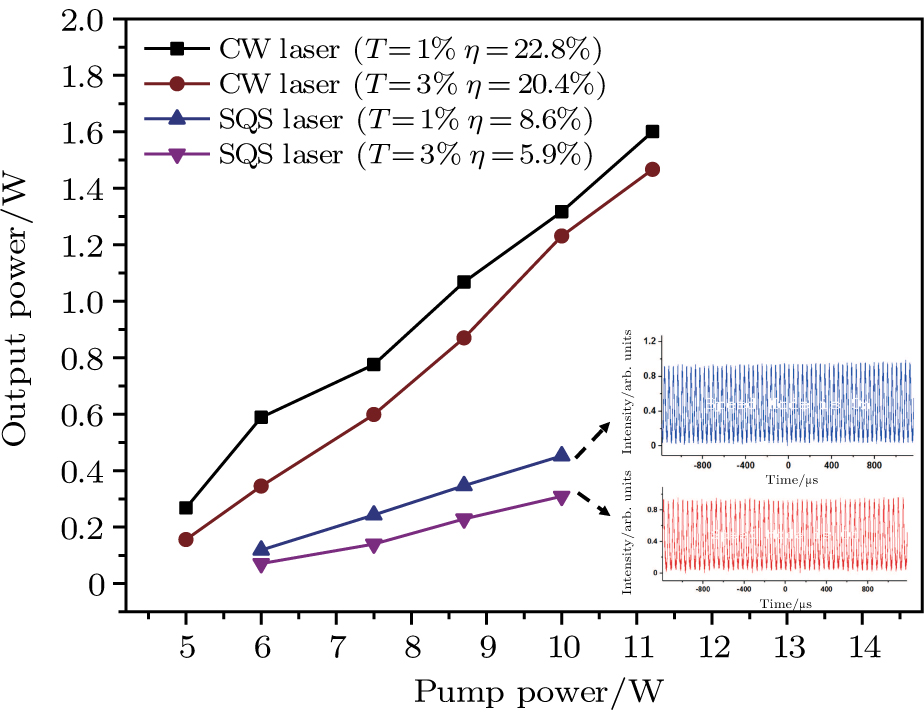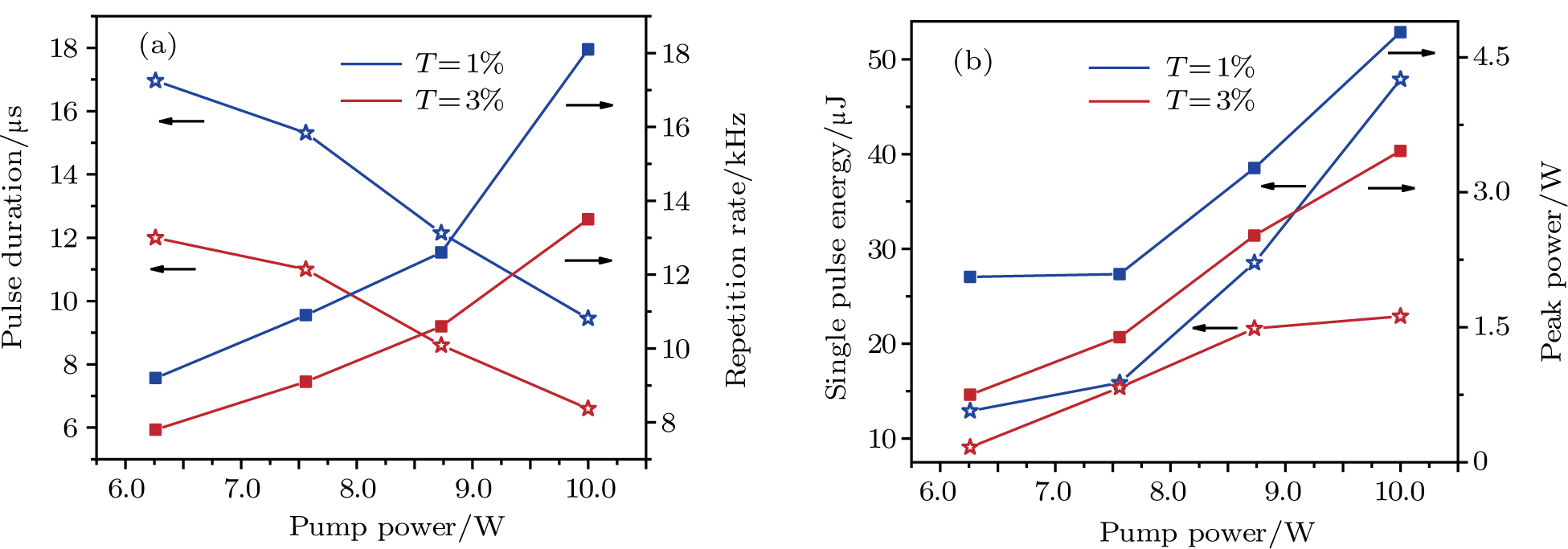† Corresponding author. E-mail:
We report the first self-Q-switched Yb-doped GdYSiO5 (Yb:GYSO) laser operating at 1080 nm. Stable Q-switched pulses with a repetition rate of 18.1 kHz and pulse duration of 

Pulsed lasers have been widely used in the fields of material processing, remote sensing, laser radar, laser ignition, optical communication, nonlinear optics, etc.[1,2] For many practical applications, a pulsed laser source with relatively high peak power, large pulse energy and tunable pulse repetition rate is favorable, which can be realized by the Q-switching technique. The Q-switched pulsed laser typically can be obtained by active modulators or saturable absorbers.[3,4] The complex structure and insertion loss of Q-switchers restricts the development of pulsed laser. Another method of generating the Q-switched pulsed laser is self-Q-switching. There are multiple mechanisms of the self-Q-switching formation, such as Kerr lensing,[5] Brillouin scattering,[6] re-absorption of gain medium,[7] nonlinear loss,[8] and stimulated scattering.[9] There are some reports about self-Q-switched Yb3+ crystal laser. Low-threshold diode-pumped Yb3+, Na+:CaF2 self-Q-switched laser was demonstrated in 2005.[10] A self-Q-switched and orthogonally polarized dual-wavelength laser was investigated with Yb:CGB crystals in 2014.[11] Self-Q-switching was observed in a bulk Yb:KGW oscillator in 2015.[12] No additional modulation elements are required in the self-Q-switched laser cavity, which reduces the laser volume and cost considerably.
The alloyed Yb:GYSO crystal was grown by the Czochraski method from a 50/50 solution of GSO and YSO,[13] which exhibits the C2/c structure. The Yb:GYSO has the advantages of a low pump threshold, excellent laser performance, desirable mechanical properties and long fluorescence lifetime. The absorption and emission spectra of Yb:GYSO crystal are shown in Fig.
 | Fig. 1. (color online) Absorption and emission spectra of Yb:GYSO laser crystal at room-temperature.[13] |
In this paper, we use a bulk Yb:GYSO crystal as a gain medium without any saturable absorbers in the cavity, realize the stable self-Q-switching operating near 1080 nm, and obtain pulses with a wavelength as short as 

The experimental setup of the self-Q-switched Yb:GYSO laser is shown in Fig. 

In experiment, the laser oscillates in a cw mode after fine collimation and the pump threshold is measured to be 3.4 W and 4.6 W with different output transmission values of 1% and 3% respectively. The threshold of cw laser in our experiment is higher than those of similar Yb3+-doped solid lasers,[13,18] which is due to the fact that the cavity is designed for self-Q-switching, and the mode matching between pump laser and oscillating laser is not optimum. After we finely tune the tilt angle of the OC, the laser is turned to the pulsed state when the pump power exceeds 6 W in the two cases. The relationship between the output power and the pump power is shown in Fig.
 | Fig. 3. (color online) Plots of output power in the cw mode and self-Q-switched state versus pump power under different transmission values of OC. |
The pulse duration and the repetition rate of the self-Q-switched pulses versus pump power are shown in Fig. 







 | Fig. 4. (color online) (a) Pulse duration and pulse repetition rate versus the absorbed pump power. (b) Single-pulse energy and peak power versus absorbed pump power. |
In Fig. 

The spectra of the cw laser and self-Q-switched pulses are detected by a spectrometer (S2000, Ocean Optics) with a resolution of 0.8 nm, and the results are shown in Fig.
 | Fig. 6. (color online) Typical spectra for self-Q-switched pulses with OC of T = 1% and 3%, respectively. |
As to the mechanism of formation, we note that the self-Q-switching is observed in Yb:CGB crystal, which is attributed to the re-absorption effect for the long-lifetime Yb3+ crystal.[11] The Yb:GYSO crystal also exhibits a comparatively large excited-state lifetime, which is as high as 1.92 ms. The long excited-state lifetime ensures the considerable accumulation of inversion population during re-absorption. When the population of ground state is minimized and the excited state is fully populated, the re-absorption loss decreases rapidly, which acts as a saturable absorber, and thus resulting in the formation of Q-switching. After that, the saturated absorber recovers from saturated state to unsaturated state. With the continuous pumping, the gain population is reversed, rebooting the re-absorption for the next Q-switched pulse. When the gain is far above the re-absorption loss with the pump increasing, the re-absorption keeps up full bleach and the gain medium stores low energy. As a result, the Q-switching tends to be unstable and the laser finally would turn into cw operation, which is consistent with our experimental result. So, we believe that the self-Q-switching can be attributed to the re-absorption effect of the Yb:GYSO crystal with long excited-state lifetime. In our experiment, the reabsorption effect can be improved by modulating the Fresnel loss of OC and the cavity loss, meanwhile, the output power is reduced because of the misalignment of the OC. However, the laser cannot oscillate when the loss is too large. Therefore, for the self-Q-switched laser, the Fresnel loss and the cavity loss must be properly controlled to start self Q-switching while sustaining laser oscillation, which entails much experimental research. The different reabsorption effect results in different repetition rates and pulse durations. In the next work, we can adjust the re-absorption effect by changing the cavity structure and output transmission to shorten pulse duration and increase peak power.
In this work, we demonstrate the first self-Q-switched Yb:GYSO laser operating at 



| [1] | |
| [2] | |
| [3] | |
| [4] | |
| [5] | |
| [6] | |
| [7] | |
| [8] | |
| [9] | |
| [10] | |
| [11] | |
| [12] | |
| [13] | |
| [14] | |
| [15] | |
| [16] | |
| [17] | |
| [18] |



